Circularly Polarized Asymmetric Single-Point Probe-Fed Hybrid Dielectric Resonator Antenna for Wireless Applications
Abstract
1. Introduction
2. Design and Analysis of Proposed Hybrid DRA
2.1. Proposed HDRA
2.2. Composition and Field Analysis of the Proposed HDRA
3. Prototype, Measurements, Discussion, and Assessment of Results
4. Conclusions and Future Scope
Funding
Data Availability Statement
Acknowledgments
Conflicts of Interest
References
- Luk, K.M.; Leung, K.W. Dielectric Resonator Antennas; Research Studies Press: Hertfordshire, UK, 2003; Volume 11. [Google Scholar]
- Yung, E.K.; Lee, W.W.; Luk, K.M. Microstrip antenna top-loaded by a dielectric resonator. Microw. Opt. Technol. Lett. 1994, 7, 55–57. [Google Scholar] [CrossRef]
- George, J.; Aanandan, C.K.; Mohanan, P.; Nair, K.G.; Sreemoolanathan, H.; Sebastian, M.T. Dielectric-resonator-loaded microstrip antenna for enhanced impedance bandwidth and efficiency. Microw. Opt. Technol. Lett. 1998, 17, 205–207. [Google Scholar] [CrossRef]
- Bijumon, P.V.; Menon, S.K.; Sebastian, M.T.; Mohanan, P. Enhanced bandwidth microstrip patch antennas loaded with high permittivity dielectric resonators. Microw. Opt. Technol. Lett. 2002, 35, 327–330. [Google Scholar] [CrossRef]
- Gupta, V.; Sinha, S.; Koul, S.K.; Bhat, B. Wideband dielectric resonator-loaded suspended microstrip patch antennas. Microw. Opt. Technol. Lett. 2003, 37, 300–302. [Google Scholar] [CrossRef]
- Esselle, K.P.; Bird, T.S. A hybrid-resonator antenna: Experimental results. IEEE Trans. Antennas Propag. 2005, 53, 870–871. [Google Scholar] [CrossRef]
- Fray, A.F. Dielectric Resonator Antenna with Wide Bandwidth. U.S. Patent 5,453,754, 26 September 1995. [Google Scholar]
- Ittipiboon, A.; Petosa, A.; Thirakoune, S. Bandwidth enhancement of a monopole using dielectric resonator antenna loading. In Proceedings of the 2002 9th International Symposium on Antenna Technology and Applied Electromagnetics, St. Hubert, QC, Canada, 31 July–2 August 2002; pp. 1–4. [Google Scholar]
- Lapierre, M.; Antar, Y.M.; Ittipiboon, A.; Petosa, A. A wideband monopole antenna using dielectric resonator loading. In Proceedings of the IEEE Antennas and Propagation Society International Symposium. Digest. Held in Conjunction with: USNC/CNC/URSI North American Radio Science Meeting (Cat. No. 03CH37450), Columbus, OH, USA, 22–27 June 2003; Volume 3, pp. 16–19. [Google Scholar]
- Lapierre, M.; Antar, Y.M.; Ittipiboon, A.; Petosa, A.A. Ultra-wideband monopole/dielectric resonator antenna. IEEE Microw. Wirel. Compon. Lett. 2005, 15, 7–9. [Google Scholar] [CrossRef]
- Guha, D.; Antar, Y.M.M.; Ittipiboon, A.; Petosa, A.; Lee, D. Improved design guidelines for the ultra-wideband monopole-dielectric resonator antenna. IEEE Antennas Wirel. Propag. Lett. 2006, 5, 373–376. [Google Scholar] [CrossRef]
- Yang, N.; Leung, K.W. Compact Cylindrical Pattern-Diversity Dielectric Resonator Antenna. IEEE Antennas Wirel. Propag. Lett. 2019, 19, 19–23. [Google Scholar] [CrossRef]
- Nalanagula, R.; Darimireddy, N.K.; Kumari, R.; Park, C.-W.; Reddy, R.R. Circularly Polarized Hybrid Dielectric Resonator Antennas: A Brief Review and Perspective Analysis. Sensors 2021, 21, 4100. [Google Scholar] [CrossRef] [PubMed]
- Sujatha, M.; Reddy, R.R.; Darimireddy, N.K. Circularly Polarized Compact Wideband Slotted Cylindrical Dielectric Resonator Antennas. In Proceedings of the IEEE International Conference on Antennas Innovation & Modern Techno. For Ground, Aircraft and Satellite Applications, Bangalore, India, 24–26 November 2017; pp. 1–5. [Google Scholar]
- Kumar, R.; Chaudhary, R.K. Circularly Polarized Rectangular DRA Coupled Through Orthogonal Slot Excited with Microstrip Circular Ring Feeding Structure for Wi-MAX Applications. Int. J. RF Microw. Comput. Aided Eng. 2018, 28, e21153. [Google Scholar] [CrossRef]
- Darimireddy, N.K.; Park, C.W. Electromagnetic Coupled Circularly Polarized Hybrid Antenna for LTE Applications. In Proceedings of the 2020 IEEE International Symposium on Antennas and Propagation and North American Radio Science Meeting, Montreal, QC, Canada, 5–10 July 2020; pp. 401–402. [Google Scholar] [CrossRef]
- Antar, Y.M.M.; Guha, D. Composite and Hybrid Dielectric Resonator Antennas: Recent Advances and Challenges. In Proceedings of the 23 National Radio Science Conference (NRSC’2006), Menouf, Egypt, 14–16 March 2006; pp. 1–7. [Google Scholar]
- Stout, S.M. Compact Dielectric-Loaded Patch Antennas for L-Band Mobile Satellite Applications. Master’s Thesis, Carleton University, Ottawa, ON, Canada, September 1999. [Google Scholar]
- Currie, C.J.; Antar, Y.M.; Petosa, A.; Ittipiboon, A. Compact Circularly Polarized Antenna Designs using Dielectrics. In Proceedings of the URSI Conference, Victoria, BC, Canada, 13–17 May 2001; pp. 359–361. [Google Scholar]
- Currie, C.J.; Antar, Y.M.M.; Petosa, A.; Ittipiboon, A. Compact Dielectric Loaded Circularly Polarized Microstrip Antenna. Electron. Lett. 2001, 37, 1104–1105. [Google Scholar] [CrossRef]
- Hsiao, F.-R.; Chiou, T.-W.; Wong, K.-L. Circularly Polarized Low-Profile Square Dielectric Resonator Antenna with a Loading Patch. Microw. Opt. Technol. Lett. 2001, 31, 157–159. [Google Scholar] [CrossRef]
- Perron, A.; Denidni, T.A.; Sebak, A.R. Circularly Polarized Microstrip/Elliptical Dielectric Ring Resonator Antenna for Millimeter-Wave Applications. IEEE Antennas Wirel. Propag. Lett. 2010, 9, 783–786. [Google Scholar] [CrossRef]
- Zhao, G.; Zhou, Y.; Wang, J.R.; Tong, M.S. A Circularly Polarized Dielectric Resonator Antenna Based on Quasi-Self-Complementary Metasurface. IEEE Transa. Antennas. Propag. 2022, 70, 7147–7151. [Google Scholar] [CrossRef]
- Kiyani, A.; Nasimuddin, N.; Hashmi, R.M.; Baba, A.A.; Abbas, S.M.; Esselle, K.P.; Mahmoud, A. A Single-Feed Wideband Circularly Polarized Dielectric Resonator Antenna Using Hybrid Technique with a Thin Metasurface. IEEE Access 2022, 10, 90244–90253. [Google Scholar] [CrossRef]
- Rajasekhar, N.; Kumari, R.; Darimireddy, N.K.; Chehri, A. A Hybrid Dielectric Resonator Antenna with Dual Sense Circular Polarization for Wireless LAN Applications. In Human Centred Intelligent Systems: Proceedings of KES-HCIS 2022 Conference; Springer Nature: Singapore, 2022; pp. 171–178. [Google Scholar]
- Massie, G.; Caillet, M.; Clenet, M.; Antar, Y.M.M. A New Wideband Circularly Polarized Hybrid Dielectric Resonator Antenna. IEEE Antennas Wirel. Propag. Lett. 2010, 9, 347–350. [Google Scholar] [CrossRef]
- Massie, G.; Caillet, M.; Clenet, M.; Antar, Y.M.M. Wideband Circularly Polarized Hybrid Dielectric Resonator Antenna. U.S. Patent 8,928,544, 6 January 2015. [Google Scholar]
- Zou, M.; Pan, J. Wideband Hybrid Circularly Polarized Rectangular Dielectric Resonator Antenna Excited by Modified Cross-Slot. Electron. Lett. 2014, 50, 1123–1125. [Google Scholar] [CrossRef]
- Lu, L.; Jiao, Y.-C.; Zhang, H.; Wang, R.; Li, T. Wideband Circularly Polarized Antenna with Stair-Shaped Dielectric Resonator and Open-Ended Slot Ground. IEEE Antennas Wirel. Propag. Lett. 2016, 15, 1755–1758. [Google Scholar] [CrossRef]
- Chowdhury, R.; Mishra, N.; Sani, M.M.; Chaudhary, R.K. Analysis of a Wideband Circularly Polarized Cylindrical Dielectric Resonator Antenna with Broadside Radiation Coupled with Simple Microstrip Feeding. IEEE Access 2017, 5, 19478–19485. [Google Scholar] [CrossRef]
- Iqbal, J.; Illahi, U.; Sulaiman, M.I.; Alam, M.M.; Su’ud, M.M.; Yasin, M.N.M. Mutual Coupling Reduction using Hybrid Technique in Wideband Circularly Polarized MIMO Antenna for WiMAX Applications. IEEE Access 2019, 7, 40951–40958. [Google Scholar] [CrossRef]
- Petosa, A. Dielectric Resonator Antenna Handbook; Artech House: Norwood, MA, USA, 2007. [Google Scholar]
- Gangwar, R.K.; Sharma, A.; Gupta, M.; Chaudhary, S. Hybrid Cylindrical Dielectric Resonator Antenna with HE11δ and HE12δ Mode Excitation for Wireless Applications. Int. J. RF Microw. Comput. Aided Eng. 2016, 26, 812–818. [Google Scholar] [CrossRef]
- Kajfez, D.; Glisson, A.; James, J. Computed Modal Field Distributions of Isolated Dielectric Resonators. IEEE Trans. Microw. Theory Tech. 1984, 32, 1609–1616. [Google Scholar] [CrossRef]


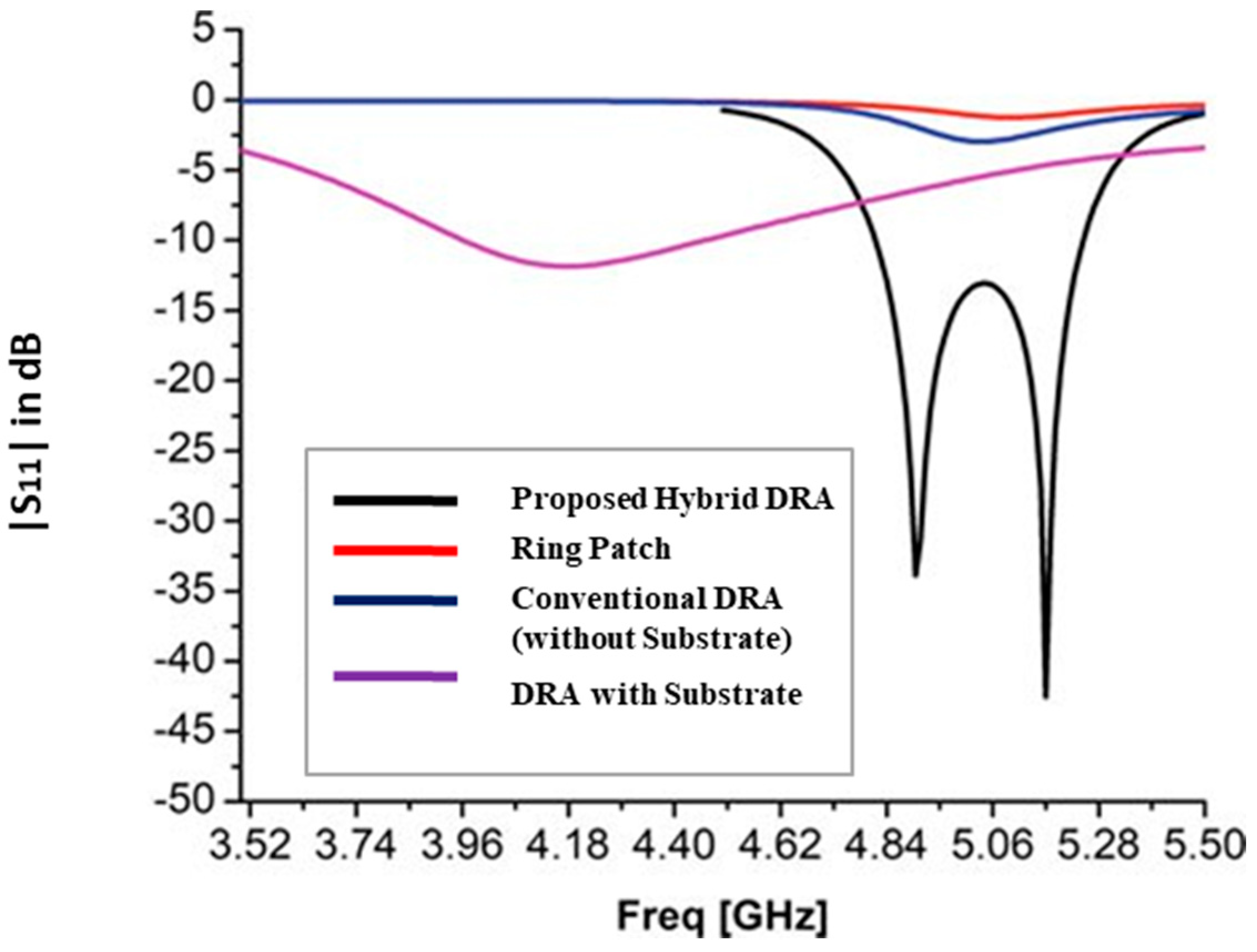



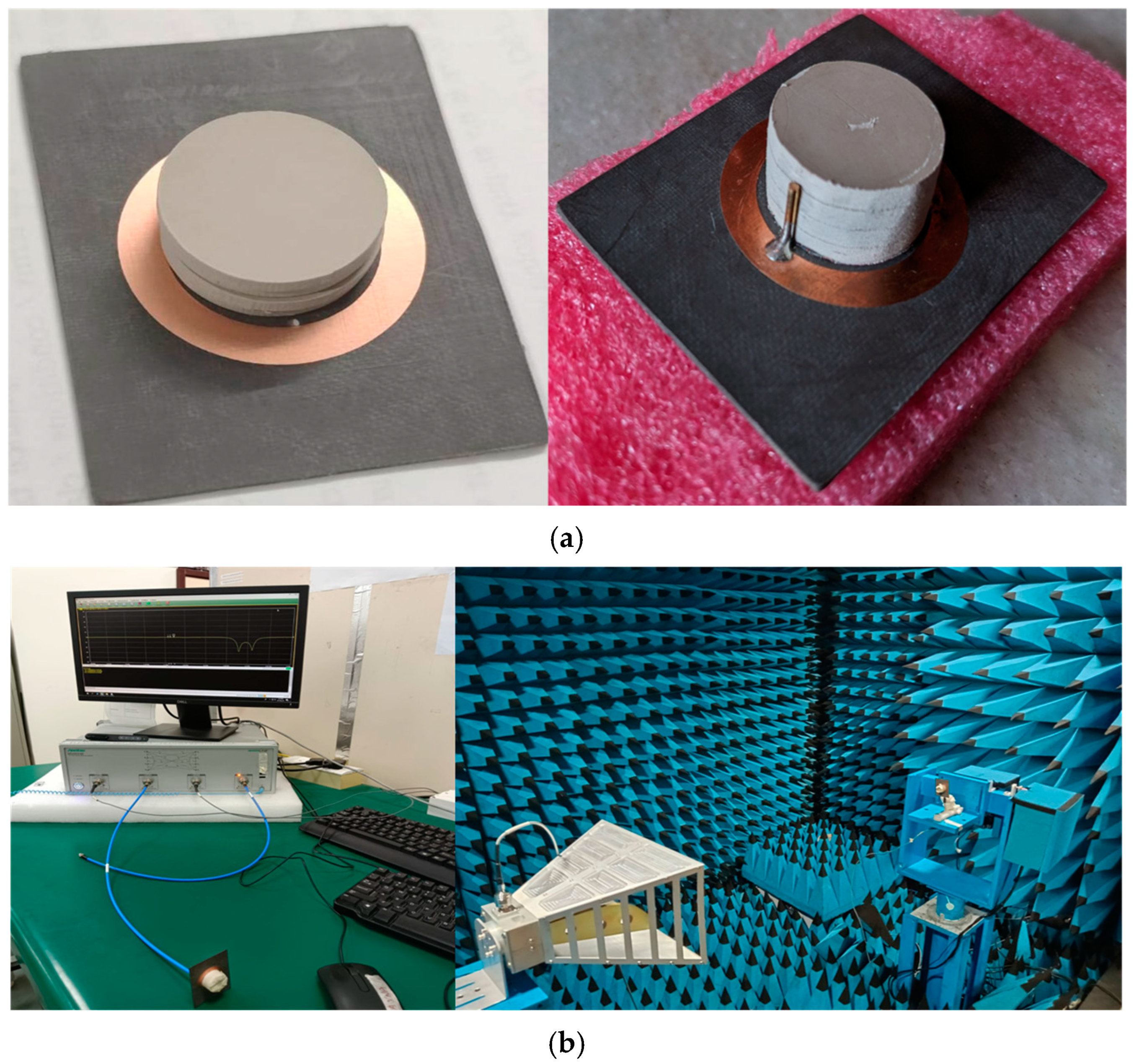
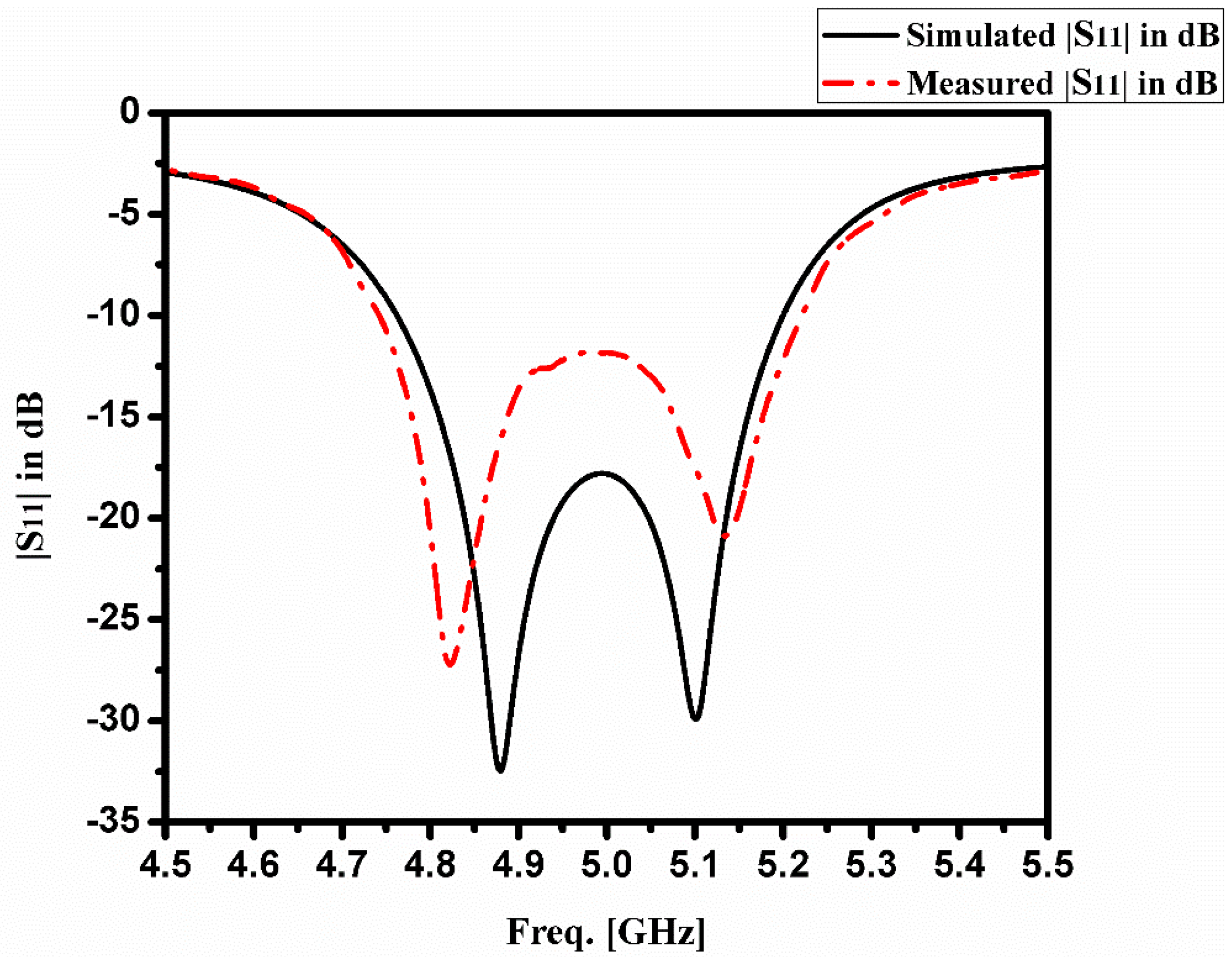
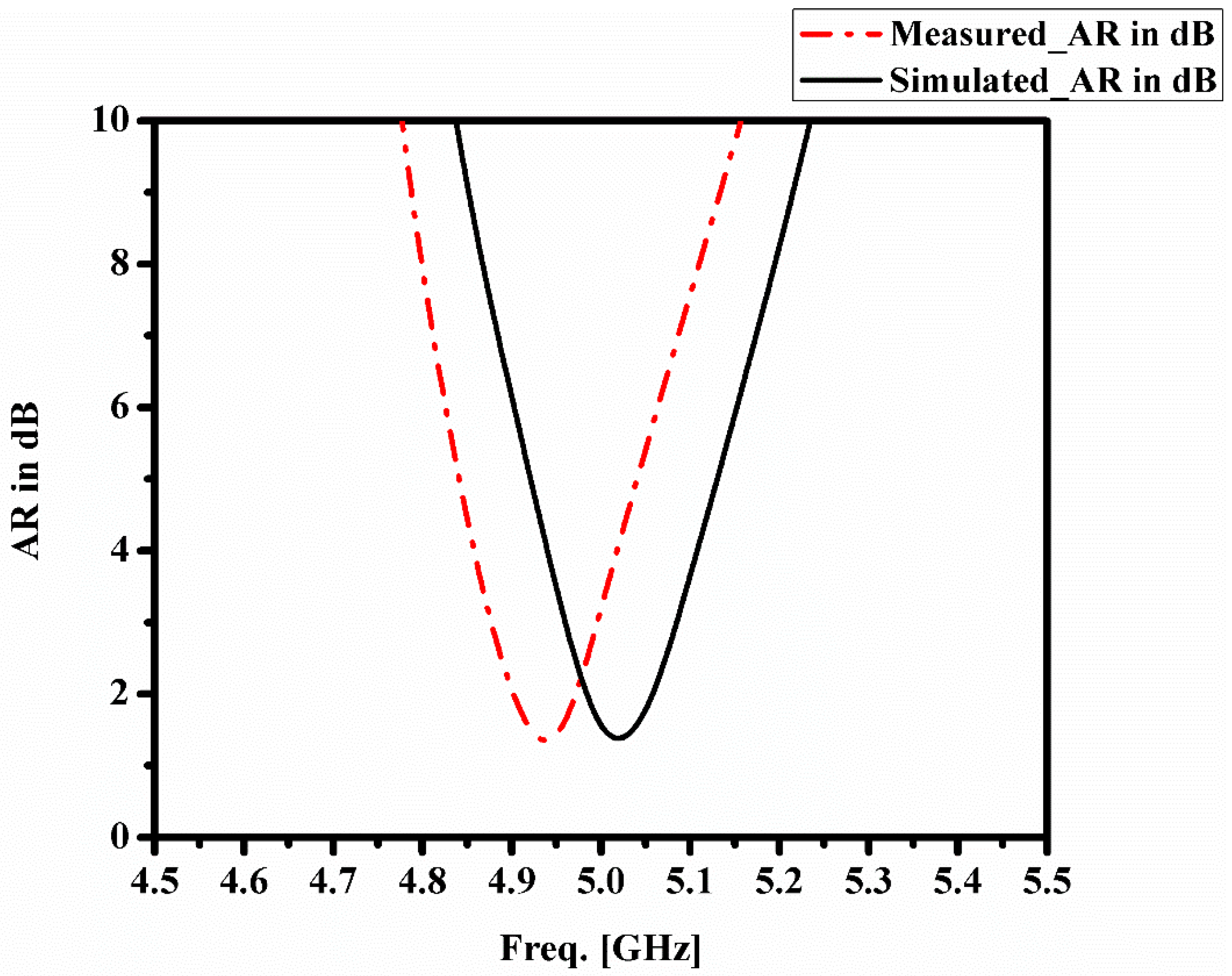

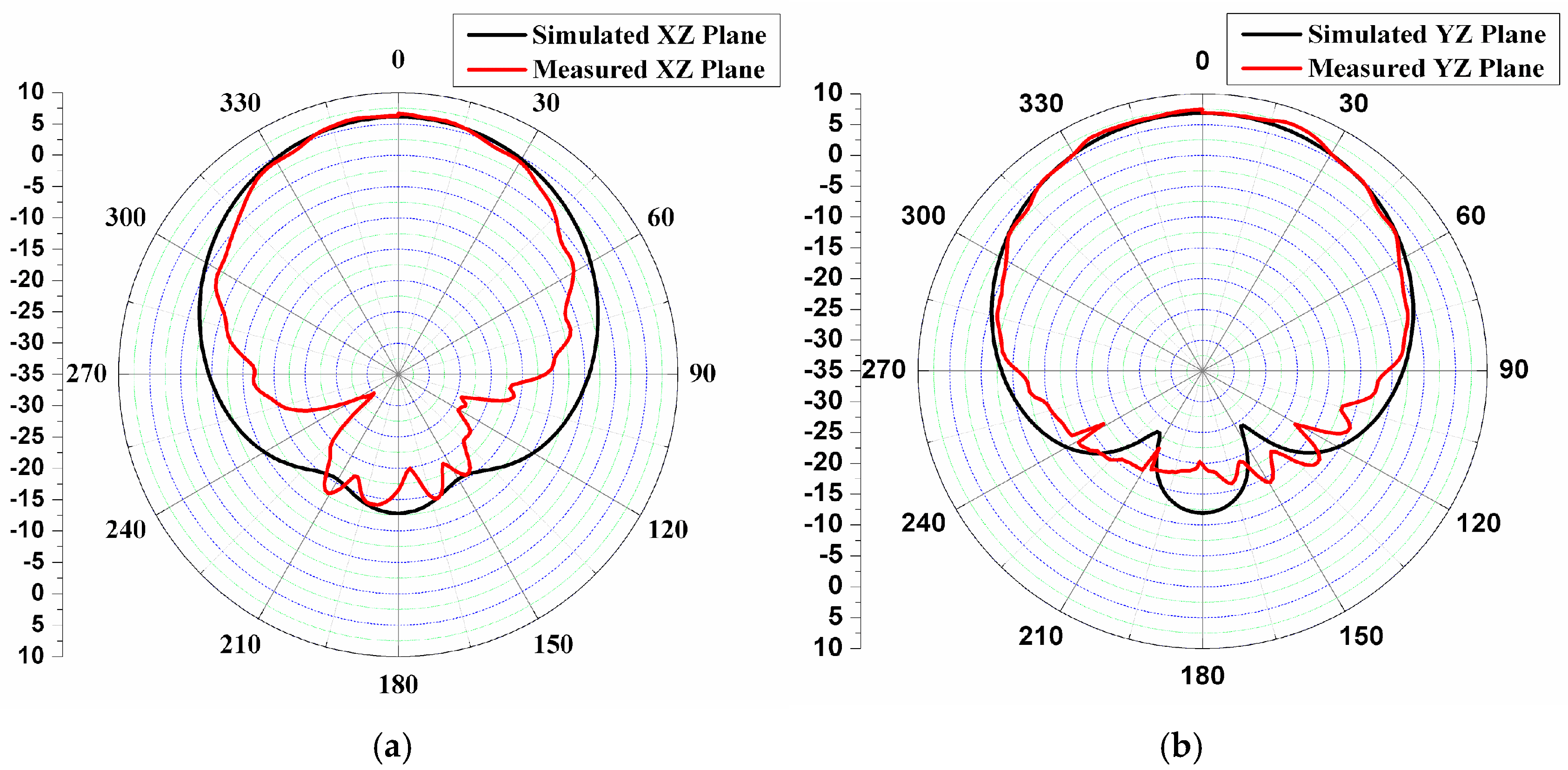
| Parameter | Simulated Results | Measured Results |
|---|---|---|
| Operating frequency band | 4760–5200 MHz | 4740–5225 MHz |
| RL-Bandwidth | 485 MHz | 440 MHz |
| AR-Bandwidth | 150 MHz | 150 MHz |
| Gain | 7.03 dBic | 6.9 dBic |
| [Ref.] | Feeding Mechanism | CP Is Achieved by | Volume of the HDRA (in Terms of λ at fr) (L × W × Heff) | fr (or) CP Bands of Resonance (GHz) | Gain (dBic) |
|---|---|---|---|---|---|
| [23] | Penetrated coax feed | Quasi-self-complementary characteristic of the metasurface | 6.08 λ × 4 λ × 0.06 λ | 24.65–26.06 | 6.03 |
| [24] | Perturbed probe feed | Due to plus shaped unit-cells based metasurface and rectangular DR | 0.93 λ × 1.29 λ × 0.16 λ | 3.6–6.6 | 6–7.2 |
| [26] | Aperture coupled | Having a feeding network composed of four microstrip lines, where the four slots are geometrically arranged to ensure circular polarization | 0.8 λ × 0.8 λ × 0.12 λ | 1.08–1.82 | 5 |
| [27] | Aperture coupled | Due to the arc-shaped slots | 0.8 λ × 0.8 λ × 0.118 λ | 1.22–1.71 | 3 |
| [28] | Aperture coupled | Modified cross-slot | 0.43 λ × 0.43 λ × 0.29 λ | 2.19–2.92 | 5 |
| [29] | An offset aperture coupled feed | Combination of Stair-shaped DR and open-ended slot on the ground plane with an offset feed | 0.46 λ × 0.46 λ × 0.07 λ | 3.844–8.146 | 3.9 |
| [30] | Dual orthogonal microstrip line | Dual vertical microstrip lines with L-shaped microstrip-line arranged perpendicularly to excite orthogonal modes | 0.59 λ × 0.59 λ × 0.26 λ | 2.82–3.83 | 5.5 |
| [31] | Combination of probe feed and conformal E-shaped patch | Parasitic patch positioned at an optimized distance next to the conformal metal-strip of two identical rectangular DRAs is utilized to generate circular polarization | 0.46 λ × 0.46 λ × 0.34 λ | 3.50–4.95 | 6.2 |
| Proposed Work | Single point probe feed | Combined asymmetric nature of circular ring patch and cylindrical DR element | λ × 0.75 λ × 0.18 λ | 4.740–5.225 | 7.03 |
Disclaimer/Publisher’s Note: The statements, opinions and data contained in all publications are solely those of the individual author(s) and contributor(s) and not of MDPI and/or the editor(s). MDPI and/or the editor(s) disclaim responsibility for any injury to people or property resulting from any ideas, methods, instructions or products referred to in the content. |
© 2025 by the author. Licensee MDPI, Basel, Switzerland. This article is an open access article distributed under the terms and conditions of the Creative Commons Attribution (CC BY) license (https://creativecommons.org/licenses/by/4.0/).
Share and Cite
Darimireddy, N. Circularly Polarized Asymmetric Single-Point Probe-Fed Hybrid Dielectric Resonator Antenna for Wireless Applications. Telecom 2025, 6, 8. https://doi.org/10.3390/telecom6010008
Darimireddy N. Circularly Polarized Asymmetric Single-Point Probe-Fed Hybrid Dielectric Resonator Antenna for Wireless Applications. Telecom. 2025; 6(1):8. https://doi.org/10.3390/telecom6010008
Chicago/Turabian StyleDarimireddy, NareshKumar. 2025. "Circularly Polarized Asymmetric Single-Point Probe-Fed Hybrid Dielectric Resonator Antenna for Wireless Applications" Telecom 6, no. 1: 8. https://doi.org/10.3390/telecom6010008
APA StyleDarimireddy, N. (2025). Circularly Polarized Asymmetric Single-Point Probe-Fed Hybrid Dielectric Resonator Antenna for Wireless Applications. Telecom, 6(1), 8. https://doi.org/10.3390/telecom6010008






